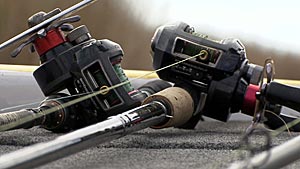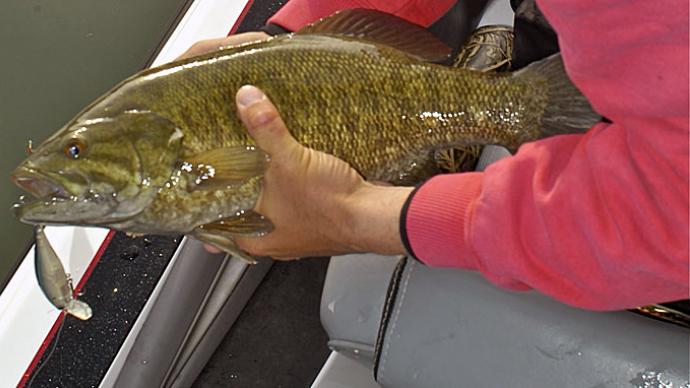
Excellent advice to help you choose the types of fishing lines best suited to different presentations and technical information about specific manufacturer's brands are widely available in fishing magazines and online websites. This article is designed to pick up where those articles leave off by presenting a fishing line system (FLS) for using various lines in the most practical, convenient, and flexible fashion possible.
Introduction
Today's bass anglers are fortunate to have a wide variety of fishing lines available for their spinning and baitcasting outfits. These selections include three basic types of lines:
- Monofilament - when line stretch or buoyancy is needed.
- Fluorocarbon - when lower visibility or quicker sinking are called for.
- Braided - when optimum abrasion resistance or zero line stretch would be beneficial.
Within each of these types, there are various options, including pound test, color, line diameter, biodegradable properties, etc. More often than not, you may find that you do not have precisely the right line spooled up on the outfits you bring to the water because there is a different type of line or pound test preferable for the fishing conditions at that time and place. By taking maximum advantage of the lines currently available, I developed a Fishing Line System that is relatively simple to use.
The Fishing Line System (FLS)
The basis of the FLS is to spool all your reels nearly full with your favorite braided line. On my spinning reels, I spool thirty pound test line (eight pound mono equivalent diameter), except for my medium-light power finesse rig, on which I use ten pound test line(two pound mono equivalent diameter). On my bait casting reels, I spool fifty pound test line (twelve pound mono equivalent diameter), except for my extra heavy power swim bait rod, on which I use sixty-five pound test line (sixteen pound mono equivalent diameter).
When braided line is called for, I am ready to fish without modifications by just tying directly to the terminal tackle. I do so when zero line stretch is critical, or line visibility is not essential, such as fishing through heavy weeds or in murky waters.
On the other hand, when the characteristics of monofilament or fluorocarbon are needed, I simply tie on an appropriate length of leader line of suitable type and pound test. Consider the following examples to illustrate the point. Remember that you will customize your approach by attaching a leader of the same line type and pound test you would ordinarily choose for the presentation while using a leader length suitable to the situation.
Some examples of my FLS using fluorocarbon line for the leader: For a finesse drop shot presentation in clear water, I typically attach a three-foot fluorocarbon six or eight-pound test leader to reduce visibility. If conditions warrant a relatively fast sink rate than other types of line afford, such as working a deep diving crankbait, I will attach a five-foot to ten-foot fluorocarbon leader of ten or twelve-pound test. If dragging a Carolina or split shot in clear water over abrasive cover, I usually go with a three- or four-foot fluorocarbon leader attached to a ball-bearing swivel tied to the main braided line.
Some examples of my FLS using monofilament line for the leader: For topwater presentations that call for a more buoyant line or for fast-moving lures with treble hooks where I might want some line stretch, I probably would attach a five to ten-foot monofilament ten-or-twelve-pound-test leader. If I work a shallow diving crankbait in water with limited visibility, I typically go with a three-foot, twelve- to sixteen-pound monofilament test leader.
To attach the braided line to the leader, I always use the uni-knot to uni-knot connection, which simplifies matters since I use the uni-knot or improved uni-knot (also called the fishing fool knot) to connect my terminal tackle.
Significant Advantages of the Fishing Line System
- Since braided line has no memory, there are no slinky-like coils to induce tangles on spinning reels or complicated backlashes on bait casting reels. Since I began using my FLS two years ago, I have not had to cut out any line due to a tangle or overrun on either type of reel.
- The FLS maximizes flexibility, so it is no longer necessary to compromise and use the "wrong" line for any presentation. For example, in a soft-sided tackle bag, I carry spools of a wide variety of line types and pound tests to have the exact combination I need at any time by simply cutting off and retying my leader.
- Because you can quickly modify your basic setup with the FLS at any time, there is no need to continually re-spool reels, carry an excessive number of rods spooled with different lines, or carry and install numerous interchangeable spools. These benefits can be very significant when visiting new lakes on a fishing trip.
Major Disadvantages of the Fishing Line System
- You must add an extra knot in the FLS equation when incorporating a monofilament or fluorocarbon leader. Though the uni-knot-to-uni-knot connection is highly reliable and very strong, it is still a knot and thus presents one more potential point of weakness to keep under surveillance.
- Some anglers find backlashes or tangles from braided super-line more challenging than those from monofilament or fluorocarbon line. Such problems are far fewer, to begin with, using the FLS. The ones I occasionally get are not as bad as with other types of line and are usually readily removed with standard techniques like knitting needles or back-winding and pulling.
- There is a more frequent line wrap on the rod's tip with braided line than monofilament or fluorocarbon lines. However, such wraps occur infrequently, and any inconvenience in unwrapping the few I get is more than offset by the advantages already noted.
Conclusion
Try the FLS by spooling up at least one reel to use on one rod and tying on leaders from your existing stock of lines, as needed. Most readers will find this approach to bass fishing as beneficial as I do. As for me, I will never go back to the old "hope what I have spooled on the reel is what I will need today" approach.
For Further Reading
Fishing Equipment Tips. Articles about the characteristics and applications of different fishing lines that will help you select the ones most suitable for leaders in the FLS are available at www.bassresource.com.

Vince LaZara is a retired college professor who took up bass fishing a few years ago in anticipation of retirement. He angles avidly for largemouth bass regularly in various lakes in southeastern Arizona. In the Fishing Techniques section, you can find his article "Fly-Rodding for Bass" Fly-Rodding for Bass" in the Fishing Techniques section at www.bassresource.com.




